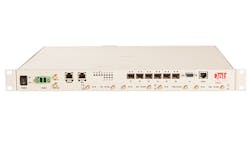Public-Safety DAS Serves to Protect the People
This file type includes high-resolution graphics and schematics when applicable.
No doubt, wireless communication has had a major impact on all of our lives. However, one critical sector—one that often gets overlooked—requires reliable wireless communications: public-safety communication. These systems rely on wireless signals to ensure the safety of people in the event of an emergency situation. First responders and emergency personnel depend on these systems to communicate without interruption.
One company that’s made public-safety solutions a priority is Dali Wireless. Its t-Series PS all-digital distributed antenna system (DAS) provides reliable public-safety coverage and access in all types of environments. In fact, the t-Series PS system was selected to provide the Dallas Fort Worth Airport with in-building public safety coverage throughout all airport terminals.
The t-Series PS system is comprised of the headend as well as medium- and high-power radio remote units. It supports FM, VHF, UHF, and 700/800-MHz frequency bands along with a wide variety of air interfaces, including P25 phase I and II, TETRA, and Tetrapol. The company says the system is LTE-ready as well.
The headend of the tSeries PS network is the tHost-ps—an all-digital and programmable software platform (see figure). The tHost-ps accepts the input from public-safety base stations or off-air repeaters, then RF signals are converted to digital data packets. Multiple tHost-ps units can be cascaded, allowing signals to be digitally processed and combined. The aggregated digital data stream is subsequently distributed via fiber-optic links at a data rate of 6 Gb/s to the remote units.
As a quad-band unit, the tHost-ps bidirectionally transfers four separate public-safety bands to the remote transceivers. It can support as many as six independent optical fibers and more than 36 remotes in a star or daisy-chained configuration. Ethernet backhaul at 1 Gb/s is available for additional devices like security cameras.
Going Remote
The t37-ps remote unit is Dali Wireless’ medium-power, dual-band remote transceiver. It provides 5 W of output power per frequency band. As a dual-band unit, the t37-ps can bidirectionally transmit and receive two public-safety bands over a single optical fiber at 6 Gb/s. In addition, it will accommodate Ethernet backhaul at 1 Gb/s. By integrating digital equalization and linearization circuits, the t37-ps is able to achieve superior error-vector-magnitude (EVM) performance. It also boasts very low additive system noise. Maximum gain is 30 dB in the uplink bands, and 40 dB in the downlink bands.
On top of that, Dali Wireless’s t43-ps high-power, dual-band remote unit delivers 20 W of output power per band. It can even be combined with a second unit to create a compact, integrated quad-band transceiver. Each high-power RF port utilizes high-rejection filters to minimize interference. The unit’s RF power amplifiers (PAs), which are implemented in a Doherty configuration, take advantage of patented adaptive equalization, digital predistortion (DPD) algorithms. As a result, the t43-ps is able to attain a high level of EVM and efficiency performance. Like the t37-ps, it boasts very low additive system noise as well.
All remote units feature DSP and network switching capabilities. They also accommodate network management, channelization, Wi-Fi and camera integration, and customer-specific applications. Monitoring and control can be performed locally via the Ethernet craft port or remotely through the tHost-ps unit.


